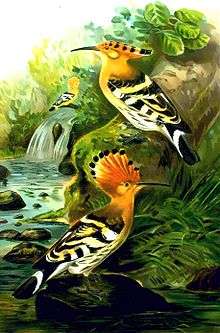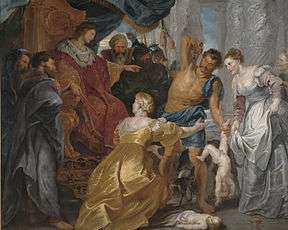Hudhud (mythology)
Hudhud (English: Hoopoe, Arabic: الهدهد, Turkish: Ibibik, Persian: هدهد, Urdu: ہوپو / ہد ہد) was, according to the Quran, the messenger and envoy of King Solomon. It refers to the sagacious birds in Islamic mythology, also referred to in The Conference of the Birds, a Persian poem by Attar of Nishapur the "king of birds".[1][2] The bird appears twice in the 27th chapter of An-Naml.[3] Hudhud, as described by the Quran played an important role between prophet Solomon and Queen of Sheba while carrying messages between the two.[4]
 Johann Friedrich Naumann, Natural history of the birds of central Europe, 3rd Ed. | |
| Grouping | Bird |
|---|---|
| Sub grouping | Hoopoe |
| Similar entities | Ababil |
| Folklore | Legend |
| Region | Kingdom of Israel |
The word "birds" appears thirteen times in the central religious text of the Muslims, while the word "bird" appears five times, including the Hoopoe twice, which in Islamic belief is often recognized as a legendary creature for mythological communication activities.[5]
Observations

A day when prophet took attendance of the birds he found hudhud missing.
Why do I not see hoopoe, or "is he among the absentees?" – either he brings me a valid proof or I will certainly punish or slaughter him severely for being absent.[6]
Later when the bird arrived he described the situation before him for being away in the meeting.
I have discovered what you have not discovered, and I have arrived to you from the "Land of Sabah" where I found a wealthy woman with wonderful throne ruling over people – An-Naml, Āyah 20 – 24.[2][7]
As a pivotal role, the hoopoe also informed Solomon that queen along with her associates, worshipped the sun. The king subsequently wrote a letter and gave it to the bird for the queen to check the authenticity of what the bird said. The queen in return, sent gifts to him but he declined to accept them all. She later visited him, saw manifestation of the Prophet, and adopted set of beliefs identified with religious conversion of Islam.[8]
Muslim belief and modern reception
Since the scientific evidence limit behavior and mental processes of the birds compared to human intelligence, Hoopoes have been a subject of discussion. Some people argue "Hudhud" was possibly a human employed for communicating messages, as a bird could not be credited with the intellectual capability of humans, concept learning and expression, which is marked by recognize patterns, solve problems, make decisions, retain information, and use language to communicate that could come to know about the queen and her government, and worship mechanism. A human, according to science is not able to understand languages of the birds with absolute certainty, the prophet, as described by the Quran was bestowed with the abilities to know what animals, including hudhud feel, see, hear, understand and think, as the bird was trained by the Prophet to collect information like humans.[5]
A book titled When Elephants Weep by Jeffrey Moussaieff Masson and Susan McCarthy have described the animal cognition, comprising a detailed account of Dogs, Cats and Ants.[9]
Mythological characteristics
Huhhud, according to an uncertain Iranian legend, was originally a married woman. Her father-in-law entered the room and found her in an uncovered state when she was combing her hair. It was embarrassing to her, so she flew with the comb on her head. Thus, the bird became known in Persian language as "Şâne-ser" (scallop headed). In Islamic literature, the main features of huhhud were to collect the information and report it to the prophet. It is also suggested that the bird was primarily involved in dowsing such as locating underground water.[10]
It has been referred to as in Turkish literature one of the sacred birds known as "Mürg-i Süleyman". The bird, according to Turkish philosophy, is given long silk on his head for his loyalty and compassion. Some mystic traditionalists credits the Hoopoe a "meaningful succession of images" while seeing in dream.[11]
References
- "Hudhud is Arabic for hoopoe". 10 October 2014 – via www.thehindu.com.
- "قصص الحيوان فى القرآن.. "هدهد" تسبب فى إسلام مملكة سبأ". اليوم السابع. 14 May 2019.
- "Birds in the Quran: The Hoopoe". 6 June 2020.
- Rosen, Jonathan (10 June 2008). "Opinion | Will Peace Take Flight?" – via NYTimes.com.
- "Birds in the Quran: Hoopoe". www.irfi.org.
- "الهدهد سر إسلام ملكة سبأ - ملاحق - رمضان - آية وتفسير - البيان". www.albayan.ae.
- "Prophet Sulayman (pbuh), Bilqees, and the Hud-Hud". 30 December 2014.
- Niaz, Mohammad (19 October 2012). "Significance of fauna". DAWN.COM.
- "Author Jeffrey Masson explores unique connections between people and pets". 7NEWS.com.au. 3 July 2020.
- "Hüdhüd nedir? Hz.Süleyman kıssasında geçen kuş..." Sabah.
- "İbibik (Upupa epops)". Evrim Ağacı.
Category:Legendary birds Category:Islamic legendary creatures Category:Quranic figures